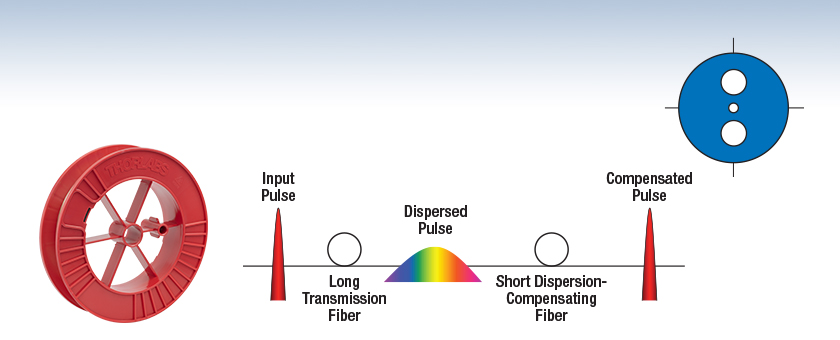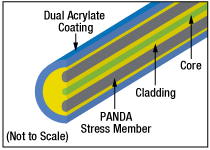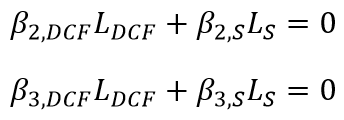Polarization-Maintaining Dispersion-Compensating Optical Fiber

- Operates Between 1510 and 1620 nm
- Dispersion: -100 ± 10 ps/(nm⋅km)
- Compensates for Both Dispersion and Dispersion Slope
- Low 1 dB Splice Loss With PM1550-XP Fiber
PMDCF
Fast Axis
Slow Axis
PANDA PM Fiber

Please Wait
| PMDCF | |
|---|---|
| Dispersion Specifications @ 1550 nm | |
| Dispersiona (Click for Plot) |
-100 ± 10 ps/(nm•km) |
| Dispersion Slopea | -0.34 ps/(nm2•km) |
| Relative Dispersion Slopea | 0.0034 ± 0.0004 nm-1 |
| Group Velocity Dispersiona | 1.275 x 105 fs2/m |
| β3/β2a | -6 fs |
| Optical Specifications | |
| Operating Wavelength, Slow Axis | 1510 - 1620 nm |
| Mode Field Diameterb | 5 µm |
| Effective Areab | 20 µm2 |
| Cut-off Wavelength, Slow Axis | 1400 nm |
| Attenuation | 0.40 dB/km (Typical) 0.45 dB/km (Max) |
| Beat Lengthb | 5 mm |
| Differential Group Delayb | 2 ps/m |
| Splicing Loss, Directb,c | 1 dB |
| General Specifications | |
| Core Diameter | Proprietaryd |
| Numerical Aperture @ 1550 nm | Proprietaryd |
| Cladding Diametere | 125 µm ± 1.5 µm |
| Coating Diametere | 250 µm ± 10 µm |

Click for Details
PANDA PM Fiber Cross Section
Features
- Dispersion and Dispersion Slope Matched to Standard PM 1550 nm Fibers
- Optimized for Slow-Axis Light Propagation
Applications
- Pulse-Stretching or Pulse-Compression Fiber
- Optical Timing Distribution Systems
- Telecommunications
Thorlabs' PMDCF Dispersion-Compensating Fiber (DCF) corrects for both the chromatic dispersion and dispersion slope of standard PM optical fiber in the 1510 to 1620 nm wavelength range. Sub-picosecond pulses are transmitted with low loss and no pulse broadening caused by chromatic dispersion, all while maintaining linear polarization. The fiber has PANDA stress rod supports that run parallel to the fiber's core and apply stress that creates a birefringence in the fiber's core which enables polarization-maintaining operation, and is specially designed for slow-axis light propagation.
PMDCF is compatible with typical fiber connectors and termination tools; however, direct coupling loss between PMDCF DCF and standard fiber can be as high as 3 dB due to the mismatch between the mode-field diameters. Losses as low as 1 dB can be achieved by creating a bridge link, i.e. fusion splicing the PMDCF to a PM fiber, such as the PM1550-XP. Splicing any DCF can be challenging due to the highly-doped trench and the high sensitivity of the mode distribution to small index profile distortions. Please contact Tech Support if you require splicing services or have questions about splicing the PMDCF fiber. For some additional information about how DCF fibers can be spliced into a system please see this paper: Grüner-Nielsen, Lars, et al., "Polarization maintaining dispersion compensating fiber." 2014 European Conference on Optical Communication (ECOC), Cannes, 2014, IEEE, pp. 1-3.
Example applications include using the PMDCF to minimize pulse delays due to polarization mode dispersion, as well as for long distance propagation for optical timing distribution systems. Additionally, this fiber can be used as both the pulse stretcher and the pulse compressor in an all-fiber, ultrafast, amplified laser system, where PM fibers are usually preferred for overall system stability.
This fiber is also available from stock as patch cables for use with 2 m or 5 m long FC/APC PM1550-XP patch cables.
Dispersion in Optical Fiber
Chromatic dispersion, D, in an optical fiber occurs when the group velocity and phase velocity of an optical pulse depend on the optical wavelength/frequency. It is primarily the sum of two components, material and waveguide dispersion:
![]()
Material dispersion arises from the change in a material's refractive index with wavelength, which changes the propagation velocity of light as a function of wavelength. Waveguide dispersion is a separate effect, arising from the geometry of the fiber optic waveguide. Waveguide properties are also a function of wavelength; consequently, changing the wavelength affects how light is guided in a single-mode fiber. For example, decreasing the wavelength will increase the relative waveguide dimensions, causing a change in the distribution of light in the cladding and core.
Another useful parameter is the dispersion coefficient, β, which is also called the phase constant or mode-propagation constant when featured in the nonlinear Schrodinger equation. If the optical pulse propagates along a fiber of length, L, then the associated phase shift is defined as:

Where dDfiber/dλ is known as the dispersion slope, which can be positive, negative, or zero, and written as:

Group velocity dispersion (GVD) is the temporal pulse broadening due to different group velocities, and it has significant influence on optical pulse widths on the order of picoseconds or shorter. The group velocity, vg, can be defined as the rate at which the entire pulse envelope will propagate:

Which allows the group velocity dispersion to be defined as:

There is no change in the shape of the temporal pulse when GVD equals zero, however there will always be temporal broadening when GVD is nonzero. When the GVD is greater than zero, the longer wavelength components will propagate faster than the shorter wavelengths; and when the GVD is less than zero, the longer wavelength components will propagate more slowly.
Polarization-mode dispersion (PMD) in typical single-mode fiber occurs as a result of birefringence in the fiber due to asymmetries in fiber stress and geometry. In the frequency domain, it presents itself as a linear change in a fixed input polarization with respect to frequency. In the time domain, it presents itself as the mean time delay of a pulse propagating along the fiber. The group delay is the difference between the mean arrival times at the fiber input and the fiber output.
Polarization-state pairs (PSP) are orthogonal pairs of polarization states at the optical fiber input. For polarization-maintaining fibers, these are the fiber’s fast and slow axes, which are treated separately and generally have different phase shifts and group delays. The differential group delay (DGD) is the difference in group delay between the orthogonal pairs of polarization states. DGD increases proportionally to the square root of the fiber length. Polarization-mode dispersion can be defined as a vector that has a magnitude equal to the DGD and points in the direction of the slow axis.
Dispersion-Compensating Fiber
Since dispersion is inevitable in optical fibers, dispersion-compensating fibers (DCF) can be incorporated into optical systems. The overall dispersion of these fibers is opposite in sign and much larger in magnitude than that of standard fiber, so they can be used to cancel out or compensate for the dispersion of a standard single-mode or polarization-maintaining fiber. A negative dispersion slope enables effective cancellation of dispersion over a larger wavelength range, since the dispersion slope of standard fiber is usually positive. Generally, a short length of DCF is spliced into a longer length of standard fiber to compensate for dispersion, as shown in the example below.

The dispersion-compensating fiber should be selected to match the dispersion of a regular SM or PM fiber, not only at a single wavelength, but over the whole spectral range of the optical pulse. This means that the DCF should match not only the dispersion, D, but the dispersion slope, dDfiber/Dλ. The ratio of these two factors is called the relative dispersion slope. Similarly, the ratio β2/β3 can be used as another numerical parameter to optimize fiber selection. The more similar these parameters are for the DCF and the standard fiber, the less distorted and impaired the transmitted optical pulse will be at the spliced fibers’ output.
To determine the optimal length for a DCF using these matching conditions, one can solve the following coupled equations using the dispersion parameters at the selected wavelength:

| Posted Comments: | |
Hossein Emami
(posted 2023-10-02 01:27:49.033) Hello. What is the zero dispersion wavelength of your PMDCF? cdolbashian
(posted 2023-10-27 03:36:38.0) Thank you for reaching out to us with this inquiry. It seems that the zero-dispersion wavelength for this fiber is beyond the cutoff wavelength where the fiber will remain single mode so we have not measured it, and cannot make an estimation. I have reached out to you directly to discuss a possible alternative. Denis Shepelev
(posted 2020-09-10 03:17:48.14) Good day.
We encountered a problem when splicing PMDCF fiber with PM 1550XP Nufern.
In the best case, we get ~ 2 dB of loss.
The best results were obtained with a decrease in the time and power of the arc, and a shift of the gap towards the 1550XP fiber.
Do you have any recommendations for a splice program? YLohia
(posted 2020-09-11 09:42:57.0) Hello, thank you for contacting Thorlabs. We splice the PMDCF to PM1550XP using arc fusion (time set to 2000 ms) and are able to achieve ~1 dB loss. This is achieved through the tapering that occurs in the fusion splicing process. It is recommended to adjust the fusion power and/or time to optimize for the lowest loss. Typically, it is beneficial to decrease the fusion power or time to get a better loss for this specific fiber. |
 Products Home
Products Home










 PM Dispersion-Compensating Fiber
PM Dispersion-Compensating Fiber